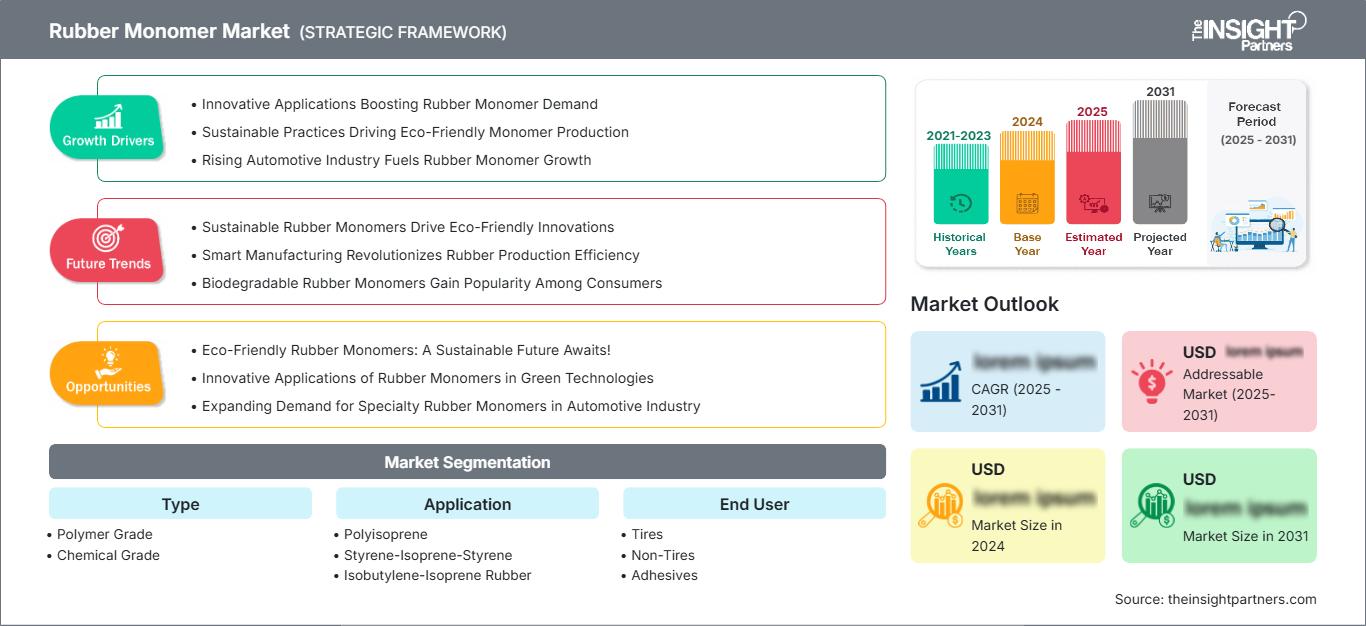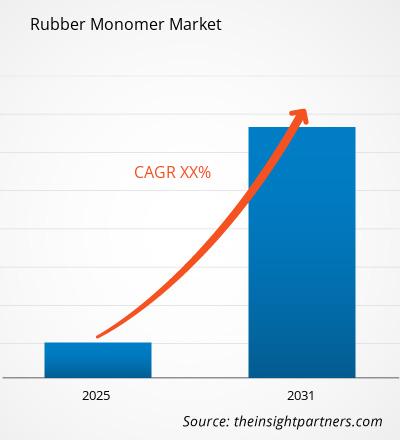Der Markt für Kautschukmonomere wird voraussichtlich zwischen 2025 und 2031 eine durchschnittliche jährliche Wachstumsrate (CAGR) von XX % verzeichnen, wobei die Marktgröße von XX Millionen US-Dollar im Jahr 2024 auf XX Millionen US-Dollar im Jahr 2031 anwachsen wird.
Der Bericht ist nach Typ (Polymerqualität, chemische Qualität) kategorisiert und analysiert den Markt weiter basierend auf der Anwendung (Polyisopren, Styrol-Isopren-Styrol, Isobutylen-Isopren-Kautschuk). Er untersucht den Markt auch nach Endverbraucher (Reifen, Nicht-Reifen, Klebstoffe). Für jedes dieser Schlüsselsegmente wird eine umfassende Aufschlüsselung auf globaler, regionaler und Länderebene bereitgestellt. Der Bericht enthält Marktgröße und Prognosen für alle Segmente und zeigt Werte in USD an. Darüber hinaus liefert er wichtige Statistiken zum aktuellen Marktstatus führender Akteure sowie Einblicke in vorherrschende Markttrends und neue Chancen.
Zweck des Berichts
Der Bericht „Rubber Monomer Market“ von The Insight Partners beschreibt die aktuelle Situation und das zukünftige Wachstum sowie die wichtigsten treibenden Faktoren, Herausforderungen und Chancen. Dadurch erhält er Einblicke für verschiedene Geschäftsinteressenten, wie beispielsweise:
- Technologieanbieter/-hersteller: Um die sich entwickelnde Marktdynamik zu verstehen und die potenziellen Wachstumschancen zu erkennen, damit sie fundierte strategische Entscheidungen treffen können.
- Investoren: Um eine umfassende Trendanalyse hinsichtlich der Marktwachstumsrate, der finanziellen Marktprognosen und der Chancen entlang der Wertschöpfungskette durchzuführen.
- Regulierungsbehörden: Um Richtlinien und Überwachungsaktivitäten auf dem Markt zu regulieren, mit dem Ziel, Missbrauch zu minimieren, das Vertrauen der Investoren zu wahren und die Integrität und Stabilität des Marktes aufrechtzuerhalten.
Marktsegmentierung für Kautschukmonomere
- Polymerqualität
- Chemische Qualität
Anwendung
- Polyisopren
- Styrol-Isopren-Styrol
- Isobutylen-Isopren-Kautschuk
Endverbraucher
- Reifen
- Nicht-Reifen
- Klebstoffe
Sie erhalten kostenlos Anpassungen an jedem Bericht, einschließlich Teilen dieses Berichts oder einer Analyse auf Länderebene, eines Excel-Datenpakets sowie tolle Angebote und Rabatte für Start-ups und Universitäten.
Markt für Kautschukmonomere: Strategische Einblicke

- Holen Sie sich die wichtigsten Markttrends aus diesem Bericht.Dieses KOSTENLOSE Beispiel umfasst Datenanalysen, die von Markttrends bis hin zu Schätzungen und Prognosen reichen.
Wachstumstreiber für den Markt für Kautschukmonomere
- Innovative Anwendungen steigern die Nachfrage nach Kautschukmonomeren
- Nachhaltige Praktiken fördern die umweltfreundliche Monomerproduktion
- Wachsende Automobilindustrie treibt Wachstum bei Kautschukmonomeren an
Zukünftige Trends im Markt für Kautschukmonomere
- Nachhaltige Kautschukmonomere fördern umweltfreundliche Innovationen
- Intelligente Fertigung revolutioniert die Effizienz der Kautschukproduktion
- Biologisch abbaubare Kautschukmonomere gewinnen bei Verbrauchern an Beliebtheit
Marktchancen für Kautschukmonomere
- Umweltfreundliche Kautschukmonomere: Eine nachhaltige Zukunft erwartet uns
- Innovative Anwendungen von Kautschukmonomeren in grünen Technologien
- Steigende Nachfrage nach Spezialkautschukmonomeren in der Automobilindustrie
Markt für Kautschukmonomere
Die Analysten von The Insight Partners haben die regionalen Trends und Faktoren, die den Markt für Kautschukmonomere im Prognosezeitraum beeinflussen, ausführlich erläutert. In diesem Abschnitt werden auch die Marktsegmente und die geografische Lage in Nordamerika, Europa, dem asiatisch-pazifischen Raum, dem Nahen Osten und Afrika sowie Süd- und Mittelamerika erörtert.Umfang des Marktberichts über Kautschukmonomere
| Berichtsattribut | Einzelheiten |
|---|---|
| Marktgröße in 2024 | US$ XX Million |
| Marktgröße nach 2031 | US$ XX Million |
| Globale CAGR (2025 - 2031) | XX% |
| Historische Daten | 2021-2023 |
| Prognosezeitraum | 2025-2031 |
| Abgedeckte Segmente |
By Typ
|
| Abgedeckte Regionen und Länder | Nordamerika
|
| Marktführer und wichtige Unternehmensprofile |
|
Dichte der Marktteilnehmer für Kautschukmonomere: Verständnis ihrer Auswirkungen auf die Geschäftsdynamik
Der Markt für Kautschukmonomere wächst rasant, angetrieben von der steigenden Endverbrauchernachfrage aufgrund von Faktoren wie sich entwickelnden Verbraucherpräferenzen, technologischem Fortschritt und einem stärkeren Bewusstsein für die Produktvorteile. Mit steigender Nachfrage erweitern Unternehmen ihr Angebot, entwickeln Innovationen, um den Verbraucherbedürfnissen gerecht zu werden, und nutzen neue Trends, was das Marktwachstum weiter ankurbelt.

- Holen Sie sich die Markt für Kautschukmonomere Übersicht der wichtigsten Akteure
Wichtige Verkaufsargumente
- Umfassende Abdeckung: Der Bericht analysiert umfassend Produkte, Dienstleistungen, Typen und Endnutzer des Marktes für Kautschukmonomere und bietet einen ganzheitlichen Überblick.
- Expertenanalyse: Der Bericht basiert auf den umfassenden Erkenntnissen von Branchenexperten und Analysten.
- Aktuelle Informationen: Der Bericht gewährleistet Geschäftsrelevanz durch die Berichterstattung über aktuelle Informationen und Datentrends.
- Anpassungsoptionen: Dieser Bericht kann an spezifische Kundenanforderungen angepasst werden und passt sich optimal an die Geschäftsstrategien an.
Der Forschungsbericht zum Markt für Kautschukmonomere kann daher dazu beitragen, die Branchensituation und die Wachstumsaussichten zu entschlüsseln und zu verstehen. Obwohl es einige berechtigte Bedenken geben kann, überwiegen die Vorteile dieses Berichts tendenziell die Nachteile.
- Historische Analyse (2 Jahre), Basisjahr, Prognose (7 Jahre) mit CAGR
- PEST- und SWOT-Analyse
- Marktgröße Wert/Volumen – Global, Regional, Land
- Branchen- und Wettbewerbslandschaft
- Excel-Datensatz
Aktuelle Berichte
Erfahrungsberichte
Grund zum Kauf
- Fundierte Entscheidungsfindung
- Marktdynamik verstehen
- Wettbewerbsanalyse
- Kundeneinblicke
- Marktprognosen
- Risikominimierung
- Strategische Planung
- Investitionsbegründung
- Identifizierung neuer Märkte
- Verbesserung von Marketingstrategien
- Steigerung der Betriebseffizienz
- Anpassung an regulatorische Trends




















 Kostenlose Probe anfordern für - Markt für Kautschukmonomere
Kostenlose Probe anfordern für - Markt für Kautschukmonomere